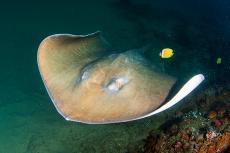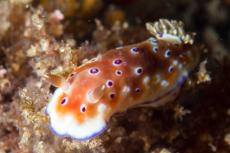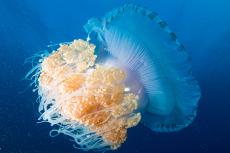Mozambique's Ponta do Ouro
When I lived in South Africa for two years a decade ago, Ponta do Ouro in neighboring Mozambique was a place of legend in the wilds beyond the KwaZaulu Natal border just a five-hour drive north of Durban. Tales told of a rustic village in the dunes with great diving, yet the village was swamped by South African fishermen off-roaders and quad-bikers during the school holidays. Whilst tempted to check out the underwater action, the tales of topside tourist trash won over, and I never made it. Then one day last August, on a whim spurred by two traveling companions while visiting South Africa again, I decided to go.
Tags & Taxonomy
The drive up from Durban was uneventful until the border, where the excellent tar road stopped and a massive squiggle of sand tracks started. All roads lead to Ponta, we were told. I was not going to try all of them, but the combination of the ones I picked at various points did lead us to the village. The drive through the sand should only be attempted in a 4x4 vehicle, it must be pointed out.
We checked in at Back to Basics, a local dive shop run and owned by the affable Rupert from South Africa, and his partner Jenny from Sweden. My traveling companions, Manu signed up for an Open Water course and Andy a refresher, whilst I was down to dive the best the dive center staff could show us in four days, which they did a great job doing.
Marine life
Ponta do Ouro has some great sites, with reefs ranging in depth from 10m at Crèche to 47m at Atlantis, with diverse and plentiful marine life, 1km to 12km in distance from the launch site on the main beach. The shallower reefs are made up of boulders and fossilized sandstone covered in soft coral, hard coral, sponges and invertebrates. Marine life ranges from the tiniest shrimps to beautiful nudibranchs, leaffish, scorpionfish, lionfish, triggerfish, surgeonfish, eels, frogfish, numerous potato bass (groupers), dolphins, mantas, turtles and up to 19 shark species, including whale sharks.
Although I was early for shark season, which runs from September to April, a group of 20-odd oceanic blacktip sharks had been hanging around for the past week, having fun with schooling baitfish, only to have disappeared the day we arrived.
Doodles. Still, the first 15-minutes out to the dive site Doodles did not disappoint; a humpback whale treated us to some tail fluking before one mighty breach and belly flop. They often put in an appearance between July and November, albeit mostly fleetingly.
Depth ranges between 14m and 18m and life includes a variety of game fish, moray eels, mantis shrimp, octopus, potato bass and rays. The reef is sandstone covered with soft coral, sponges and hard coral. At times, this reef can be invaded by so many snappers, scad and small pelagic fish that you cannot see the reef for all the fish. This abundance of food attracts various game fish and shark species to the reef.
It is also a magnet for rays needing a clean from the abundant butterfly and angelfish on the reef. In three dives here, I saw southern stingrays, leopard rays, a whiptail ray and a diamond ray, as well as three female groupers, porcupine fish, green and hawksbill sea turtles, and some abundant macro life. In such a short trip, I would not normally like diving the same site three times, but two dives with a fisheye lens were really necessary, and then one with a macro lens, as there really was lots to see on Doodles. Manu also did her final qualifying dive here, and what a place to do it!
Atlantis. The polar extreme of Doodle is called Atlantis, as the depth of this 300m long reef is between 38m and 47m. Atlantis is for experienced divers with an advanced or deep diving qualification only, and being 3km from the shore, currents can be quite strong. The topography along the edges of this reef is very interesting with drop-offs and boulders on the sand. Black coral and green tree coral are present, and common visitors are marbled rockcod, bull shark, blacktip reef shark, black coral, Spanish dancers, kingfish, sawthooth barracuda, royal seaapple, trumpet fish and jellyfish.
Steps. The depth at Steps goes from 13m at the top, tumbling into overhangs and cracks at 16m on the sand. This reef is narrow (10m to 20m wide), and runs 4km along the inside of the bay. Due to its length, it is an ideal dive on days with a strong current. Natal knife jaw, cave bass, green job fish and leaf fish are just some of the species found here. Blue spotted and round ribbon tail rays lie basking in the sand while the odd devil ray can be seen swimming along the fringes of the reef.
Steve’s Ledge. An extension of Steps, this long, thin reef ranges in depth from 14m to 19m. Anemones host clownfish, anemone crabs and shrimps. Fish life includes blue banded snappers, goatfish, trumpetfish and angelfish.
Checkers. This is another reef in the 15m to 18m range. While the topography is far from unique, the marine life inside this horseshoe reef is excellent. Clouds of blue-banded snappers, anthias and yellow back fusiliers hang out here and frogfish and the elusive pineapplefish have also been spotted here.
Crèche. A firm favorite with novice divers when there is no swell is a dive site called Crèche, taking its moniker from the abundance of juvenile fish found there. The average depth is 12m, with shallower sections of the reef coming up to 10m, with different-sized boulders and rocks on a sandy bottom. Fish life includes potato bass, crocodile fish, scorpionfish and green job fish. Ragged-tooth sharks have also been spotted here. Manu did one of her open water dives here, and Andy had a blast on his refresher.
Pinnacles Reef. The main dive site for seeing sharks in shark season is Pinnacles Reef. Popular with fishermen, divers and sea life, the area abounds with life during the summer months. It is located 3.5km off the dunes of southern Mozambique. Because the Pinnacles rise off the depths of the sea floor from 50m to 29m, the area acts as an magnet drawing fish to the area and it can attract large numbers of bull sharks. So far, a surprising 19 species of shark have been identified in the area. Out of season, when you are the only diver qualified to go deep on a boat of novices, you may not always get there, but in shark season it is visited very frequently and with much success.
A deep reef starting 28m dropping off to over 40m, huge potato bass congregate here, together with game fish, which attract sharks of all descriptions, especially zambezi (bull), hammerheads and the odd tiger shark. Mantas are also seen here, coming in for a clean. With water visibility usually around the 30m mark, this site is a firm favorite of many a visiting diver.
Atlantis. Another deeper site is Atlantis (Lego Land) with an average depth of 35m. There are big square boulders, a couple of drop-offs and an overhang before the sandy bottom, to explore. Expect to see eagle rays, reef sharks and game fish here.
In addition to the sites off Ponta do Ouro, it is also easy to reach the dive sites around Ponta Malongane and Ponta Mamoli in Back to Basics by RIB, with each spot offering more variety.
Ponta Malongane
Cloudbreak. This dive site is a long flat coral reef, busy with sharks and game fish, plus all the usual suspects seen on a deep dive. Depths can reach up to 45m (147ft), suitable for advanced divers with experience in unpredictable currents.
The Three Sisters. This dive site is just off the point and reaches a depth of 26m (85ft). There are three big boulders, an overhang and a cleaning station. Shrimp life is good and one can also spot surgeonfish, long nose hawkfish and even giant honeycomb moray eels here.
Wayne’s World. This dive site has a great swim-through and plenty of coral. Here, one will find frogfish and potato bass, rays and kingfish, to name a few. Depths reach 29m though, so this is another site for more advanced divers.
Kev’s Ledge. There is good drift diving at this site. With slow changes in depth and multiple levels to adjust to while exploring a series of widely spaced ridges with different features, it is always a fun dive. I was joined by a beautiful butterfly ray and then an inquisitive hawksbill sea turtle here. The average depth is 24m (78ft), so it is ideal for nitrox diving.
Ponta Mamoli
Bass City. For advanced divers, Bass City is wonderful if you want to see plenty of fish. The series of algae-covered rocky outcrops attract an amazing array of marine life, including more friendly potato bass. Other critters often spotted here include lionfish, juvenile boxfish, harlequin shrimp and zebra shark, to name a few. There are plenty of cleaning stations, some boulders, overhangs, and also an intriguing sandy floor at around 25m deep.
Playground. There is abundant and diverse range of marine life at this dive site, which is wonderful for a night dives as well as shallow dives in good conditions for new divers doing their Open Water certification. There is a central cave and other nooks and crannies. The depth is 12m (39ft). One can find fusiliers, soldierfish and bigeye stumpnose fish here, as well as honeycomb stingrays and sand sharks, brilliant nudibranchs and hard and soft corals.
Conditions
RIB launches can be a little sporty, but for anyone used to Aliwal Shoal or Protea Banks, they are an anti-climatic affair. For the novice, they are a fun start to any dive. The water temperature ranges from 21°C, with visibility of 15m to 25+m in winter, from April to August, and in summer, 29° C with 15 to 20m visibility is to be expected.
Topside treats
As much as underwater Ponta lived up to its reputation, it was most pleasantly unwarranted topside. Outside of the main South African holidays, it is quiet and peaceful with half a dozen decent cafes and bars serving homemade savory and sweet dishes and some excellent coffee. In the evenings, service can be a little slow at the various restaurants on the beach or up the gently-sloping sandy hill, but there is always a plentiful supply of Dois M lager and Laurentina Preta (a dark lager) to tide one over. The evenings were all decidedly quite calm and pleasant, and an extra touch of civilization was provided courtesy of DSTV (South African satellite TV) showing cricket test match highlights at the end of the day’s play.
With only four days to dive here, and without getting a chance to see the prime deeper sites, I feel like I have just starting scratching the surface. As I write, I am hankering to go back, either in October or November, or in February or March, to get a crack at the top shark sites. African dive areas this far south tend to be either mainly about big fish, à la Aliwal Shoal and Protea Banks, or abundant in small stuff and reef life, like Rocktail Bay and Sodwana. Ponta do Ouro looks like it contains the best of both worlds. ■
Christopher Bartlett is a widely-published British underwater photographer, certified FGASA African field guide and dive writer based in London. He leads photographic trips to Papua New Guinea, Southern and Eastern Africa, Mexico and the Maldives, providing free workshops and tuition. For more information, visit: Bartlettimages.com.
Download the full article ⬇︎









































